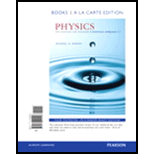
Concept explainers
For Problems 34 through 43, draw a complete pictorial representation.Do not solve these problems or do any mathematics.
34. A Porsche accelerates from a stoplight at 5.0 m/s2 for five seconds, then coasts for three more seconds. How far has it traveled?
35. A jet plane is cruising at 300 m/s when suddenly the pilot turns the engines up to full throttle. After traveling 4.0 km, the jet is moving with a speed of 400 m/s. What is the jet’s acceleration as it speeds up?
36. Sam is recklessly driving 60 mph in a 30 mph speed zone when he suddenly sees the police. He steps on the brakes and slows to 30 mph in three seconds, looking nonchalant as he passes the officer. How far does he travel while braking?
37. You would like to stick a wet spit wad on the ceiling, so you toss it straight up with a speed of 10 m/s. How long does it take to reach the ceiling, 3.0 m above?
38. A speed skater moving across frictionless ice at 8.0 m/s hits a 5.0-m-wide patch of rough ice. She slows steadily, then continues on at 6.0 m/s. What is her acceleration on the rough ice?
39. Santa loses his footing and slides down a frictionless, snowy roof that is tilted at an angle of 30º. If Santa slides 10 m before reaching the edge, what is his speed as he leaves the roof?
40. A motorist is traveling at 20 m/s. He is 60 m from a stoplight when he sees it turn yellow. His reaction time, before stepping on the brake, is 0.50 s. What steady deceleration while braking will bring him to a stop right at the light?
41. A car traveling at 30 m/s runs out of gas while traveling up a 10º slope. How far up the hill will the car coast before starting to roll back down?
42. Ice hockey star Bruce Blades is 5.0 m from the blue line and gliding toward it at a speed of 4.0 m/s. You are 20 m from the blue line, directly behind Bruce. You want to pass the puck to Bruce. With what speed should you shoot the puck down the ice so that it reaches Bruce exactly as he crosses the blue line?
43. David is driving a steady 30 m/s when he passes Tina, who is sitting in her car at rest. Tina begins to accelerate at a steady 2.0 m/s2 at the instant when David passes. How far does Tina drive before passing David?
Want to see the full answer?
Check out a sample textbook solution
Chapter 1 Solutions
Physics for Scientists and Engineers: A Strategic Approach with Modern Physics, Books a la Carte Edition; Student Workbook for Physics for Scientists ... eText -- ValuePack Access Card (4th Edition)
- Hello, please help with inputing trial one into the equation, I just need a model for the first one so I can answer the rest. Also, does my data have the correct sigfig? Thanks!arrow_forwardFind the current in the R₁ resistor in the drawing (V₁=16.0V, V2=23.0 V, V₂ = 16.0V, R₁ = 2005, R₂ = and R₂ = 2.705) 2.3052 VIT A www R www R₂ R₂ Vaarrow_forwardWhich of the following laws is true regarding tensile strength? • tensile strength T ①Fbreak = Wtfest Piece thickness rate (mm) ②T = test piece width rabe (mm) Fbreak break watarrow_forward
- No chatgpt plsarrow_forwardNo chatgpt plsarrow_forwardYou hold a spherical salad bowl 85 cm in front of your face with the bottom of the bowl facing you. The salad bowl is made of polished metal with a 40 cm radius of curvature. Where is the image of your 2.0 cm tall nose located? What is image's size, orientation, and nature. I keep getting the answer -26.2, but it keeps saying it is wrong. I just want to know what i'm doing wrong.arrow_forward
- A converging lens with a focal length of 6.70 cm forms an image of a 4.60 mm tall real object that is to the left of the lens. The image is 1.50 cm tall and erect. Where are the object and image located? Is the image real or virtual? Please show all stepsarrow_forwardNo chatgpt pls will upvotearrow_forwardneed help part earrow_forward
 College PhysicsPhysicsISBN:9781938168000Author:Paul Peter Urone, Roger HinrichsPublisher:OpenStax College
College PhysicsPhysicsISBN:9781938168000Author:Paul Peter Urone, Roger HinrichsPublisher:OpenStax College University Physics Volume 1PhysicsISBN:9781938168277Author:William Moebs, Samuel J. Ling, Jeff SannyPublisher:OpenStax - Rice University
University Physics Volume 1PhysicsISBN:9781938168277Author:William Moebs, Samuel J. Ling, Jeff SannyPublisher:OpenStax - Rice University College PhysicsPhysicsISBN:9781305952300Author:Raymond A. Serway, Chris VuillePublisher:Cengage Learning
College PhysicsPhysicsISBN:9781305952300Author:Raymond A. Serway, Chris VuillePublisher:Cengage Learning Physics for Scientists and Engineers: Foundations...PhysicsISBN:9781133939146Author:Katz, Debora M.Publisher:Cengage Learning
Physics for Scientists and Engineers: Foundations...PhysicsISBN:9781133939146Author:Katz, Debora M.Publisher:Cengage Learning College PhysicsPhysicsISBN:9781285737027Author:Raymond A. Serway, Chris VuillePublisher:Cengage Learning
College PhysicsPhysicsISBN:9781285737027Author:Raymond A. Serway, Chris VuillePublisher:Cengage Learning Physics for Scientists and Engineers with Modern ...PhysicsISBN:9781337553292Author:Raymond A. Serway, John W. JewettPublisher:Cengage Learning
Physics for Scientists and Engineers with Modern ...PhysicsISBN:9781337553292Author:Raymond A. Serway, John W. JewettPublisher:Cengage Learning





